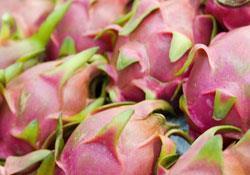
Access to the US for Vietnamese dragon fruit was only granted in July this year, but exports have already hit a virtual brick wall, according to Thanh Nien News.
Dragon fruit bound for the US market must undergo irradiation treatment – standard fare for US imports. The only commercial irradiation facility in Vietnam, however, recently shut off dragon fruit irradiation services, effectively cutting off access to the US.
Ho Chi Minh-based Son Son Seafood Processing Company is the only group in Vietnam with the equipment and certification to irradiate dragon fruit for export. The company said volumes being sent for treatment were so low it was losing money on the service.
Son Son will still irradiate its own fruit, according to Chairman Tram Be, who says the company bought the machine for US$20m six years ago for that purpose.
He said Son Son would lose money on the irradiation services for dragon fruit, which have only been exported to the US in small amounts so far.
Vietnamese dragon fruit exporters had complained in the past about the high cost of the treatment, which came to about US$1 per kilogram, compared to only US$0.24 per kilo in Thailand.
The country’s dragon fruit exports have had initial success tempered by setbacks such as this. Tony Lin of One Trade, which exports Vietnamese dragon fruit under its King Ping brand, explained the situation to Fruitnet.
“Dragon fruit is going to the US, and some is going to Europe by air as well. Some people are also doing a bit to Russia,” Mr Lin said last week.
“I’ve heard Vietnamese dragon fruit will be banned in Taiwan from next year,” he said, referring to a recent residue scare with the chemical prochloraz that led to a recall of 2,000 cartons of the fruit in Taiwan.
“We export to mainly to places like Thailand and Singapore; we haven’t got out of the Asian market, where there’s no irradiation and no quarantine problems.”



